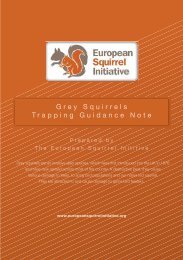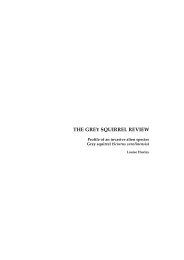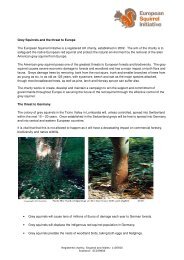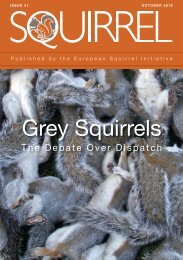6. quantification and financial implications of grey squirrel damage
6. quantification and financial implications of grey squirrel damage
6. quantification and financial implications of grey squirrel damage
Create successful ePaper yourself
Turn your PDF publications into a flip-book with our unique Google optimized e-Paper software.
Dutton (1993), only whole maize should be used for pre-baiting <strong>and</strong> hoppers must be<br />
checked every two to three days. Once the hopper becomes empty, the whole the control<br />
programme has to be re-started. Dutton also recommends applying 1 hopper / ha<br />
initially.<br />
In none <strong>of</strong> the estates illustrated here or in many others does any form <strong>of</strong> <strong>squirrel</strong> control<br />
provide an acceptable reduction in <strong>damage</strong> either because the control proves too costly or<br />
it is unsuccessful. The only exceptions are those cited by Kenward <strong>and</strong> Dutton (1996) in<br />
the previous chapter who indicate that rigorous prediction <strong>and</strong> pre-baiting exercises are<br />
required on a permanent basis, <strong>and</strong> errors will still occur. At no time or place is it<br />
possible to eradicate the <strong>grey</strong> <strong>squirrel</strong> completely with the present mechanisms for<br />
control due to the persistent endemic spread <strong>and</strong> replacement <strong>of</strong> the animal.<br />
Forestry Commission Statistics<br />
Figure <strong>6.</strong>1. Percentage <strong>of</strong> woodl<strong>and</strong> cover in Europe by country (Forestry Statistics 2002)<br />
The British Isles are relatively lightly wooded compared to continental Europe (Figure <strong>6.</strong>1).<br />
The total area <strong>of</strong> woodl<strong>and</strong> for Great Britain in 2002 as stated by the Forestry Commission<br />
(Forestry Statistics 2002) is 2.7 m ha, (11.6% <strong>of</strong> total l<strong>and</strong> area) <strong>of</strong> which 794,000 ha is Forestry<br />
Commission (or state) owned, 971,000 ha is broadleaved woodl<strong>and</strong>, 1,406,000 ha is coniferous<br />
woodl<strong>and</strong>. The coniferous element is influenced by the large percentage <strong>of</strong> woodl<strong>and</strong> in<br />
Scotl<strong>and</strong> <strong>of</strong> which less than 20% is broadleaved. In Engl<strong>and</strong>, only one third <strong>of</strong> all woodl<strong>and</strong> is<br />
coniferous, while in Wales over half is coniferous. The nature <strong>of</strong> British woodl<strong>and</strong> has<br />
changed quite considerably since the mid-19 th century as illustrated in Table <strong>6.</strong>8 which<br />
identifies how substantial coniferous planting, particularly in Scotl<strong>and</strong> in the mid- 20 th<br />
century (post World War II) has played a key part in creating the present day British<br />
l<strong>and</strong>scape.<br />
85







